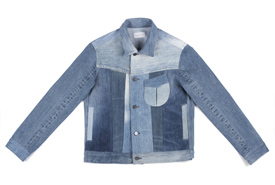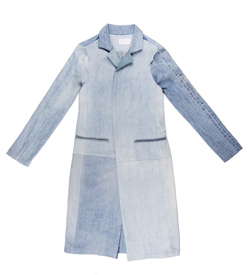Sustainability makes for great-fitting jeans

Atelier denim jacket made from repurposing the finest vintage materials. (Photo by Triarchy)
With the constant ins and outs of fashion, it’s no wonder that more and more of our discarded clothing is ending up in landfills. According to CBC News, about 85 per cent of clothing we throw out ends up in landfills, rather than appropriately recycled or donated. While there are programs being implemented to combat unwanted wardrobe items becoming a trashy trend, some designers are thinking about the environment before a garment even comes to fruition.
Take, for instance, Adam Taubenfligel, the creative director of Triarchy — a Los Angeles-based denim brand founded by Adam and his brother, Mark, and sister, Ania. Growing up in Vancouver fostered a deep appreciation for nature in the siblings, but it wasn’t until the trio watched the documentary, The True Cost, that they decided to change their ways and adopt more sustainable practices.
“When it came to manufacturing our product, we didn’t initially ask enough questions pertaining to whether [an item] could be made better or not. We just assumed this was the way you did it,” says Adam.
The True Cost shines a light on how must waste is generated from the fashion industry. Surprisingly, the fashion industry is the planet’s second-largest polluting industry, after the oil industry.
“After we were shown The True Cost, we were blown away by the damage that fast fashion is doing to our planet,” adds Adam.
One man’s trash is another man’s treasure

Some designers are making conscious choices to use less water in the production of their clothes compared to the industry standard. (Photo by Triarchy)
With consumers purchasing more and more clothing — a whopping 80 billion items per year globally (a 400 per cent increase from 20 years ago) — it’s important that we start considering how our clothing is made. This increase can be attributed to the rise of “fast fashion” — inexpensively produced clothing sold at a lower price-point. And because it’s cheap, we tend to buy more of it, even though we don’t necessarily need it.
It is estimated that each piece of clothing owned by an individual is worn approximately four times before it is discarded, and 20 per cent of items purchased are not even worn once. With landfills piling up with unwanted clothing, we need to adopt more sustainable ways to recycle garments.
How? By buying less and wearing more. By buying less clothing, especially from fast-fashion brands, we reduce our impact and the need for production. By wearing clothing more often, you are giving life to a garment, rather than letting it sit in your closet. And once you tire of the item, look into donating it to charity or a second-hand store, and giving someone else a chance to wear it.

Long blue denim jacket (Photo by Triarchy)
It's all in the details
Green jeans help conserve water. By making sustainable fashion choices, you can also help conserve water. With two billion pairs of jeans produced annually on the global level, minimizing water consumption is critical in order to sustain landscapes across the world. A pair of traditionally made cotton jeans can use up to 2,900 gallons of water, equivalent to 10,977 one-litre water bottles.
On the other hand, a pair of sustainably made jeans will consume less water than the industry standard. At Triarchy, the water used to produce jeans is 85 per cent recycled in a factory that uses a biological reactor to clean the water without chemicals. It’s a process that ends up saving over 1,500 gallons of water per pair of jeans.
Other sustainable fashion decisions may involve using recycled and sustainably farmed materials, such as Tencel cotton, a sustainable fibre made from the pulp of the eucalyptus tree. Some designers may use recycled labels for their labels and fibre from recycled water bottles.
Education is the first step to sustainable fashion
By knowing where clothing and the materials to make them are manufactured, consumers can to make more informed decisions about how their purchases impact the planet.
In 2017, Fashion Revolution reviewed 100 of the largest fashion brands across the world and found that only 32 per cent of companies were providing information about where their materials were sourced. While this is an encouraging trend, more companies need to take the initiative towards transparency to inform consumers with sustainability in mind.
“Once we made the switch [to more environmentally friendly practices], we had a focussed brand in place. With that in place, if we wanted to make something that didn’t comply with our sustainability standards, then we couldn’t make it,” Adam says.
Treating and dying textiles produce toxins, which in turn are accountable for 20 per cent of industrial water pollution.
By taking a step forward for nature, sustainably-minded designers can continue to pave the way for sustainable fashion.


